Today is a time when electric scooters are no longer something amazing. This personal transport has become more popular than bicycles, and interest in it continues to grow. We recently got an electric scooter from Polaris.
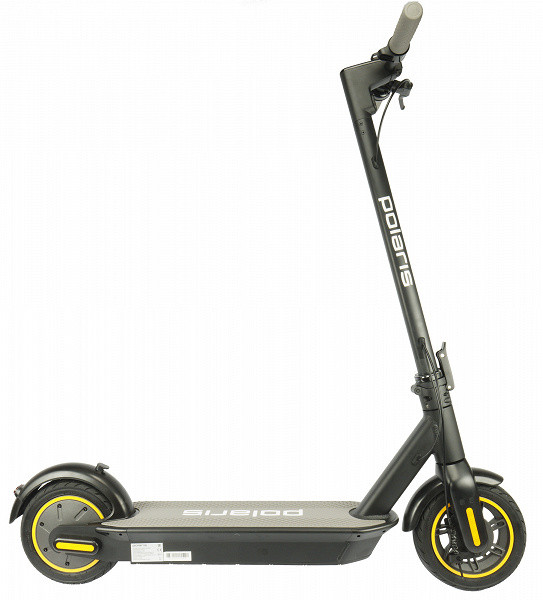
The PES 1010 model, as stated by the manufacturer, provides up to 65 kilometers of battery life on a single charge and reaches a maximum speed of up to 25 km/h. Let's take a closer look at this electric scooter and test it in action!
Characteristics
| Manufacturer | Polaris |
|---|---|
| Model | PES 1010 |
| Type | electric scooter |
| Country of Origin | China |
| Guarantee | 1 year |
| Life time * | 3 years |
| Power | 350 W |
| Power reserve | up to 65 km |
| Maximum speed | 25 km/h |
| Battery | Li-Ion, 36 V, 15000 mAh |
| Charging time | 7-8 hours |
| Wheel size | 10" |
| Wheel type | pneumatic tire |
| Brake system | electric brake + hand brake |
| Climbing grade | 15° |
| Maximum user weight | 120 kg |
| Integration with smartphone | No |
| Additionally | Cruise control, LCD display on steering column, LED course light, tail light/brake light, auto power off function |
| Weight | 17.6 kg |
| Dimensions | 115×48×17 cm |
| Network cable length | 2.1 m |
* Contrary to popular belief, this is not a period after which the device will necessarily break down. However, after this period, the manufacturer ceases to bear any responsibility for its functionality and has the right to refuse to repair it, even for a fee.
Equipment
The Polaris PES 1010 electric scooter is supplied in a durable rectangular voluminous box. The packaging is made with special attention to detail: high-quality printing, a white background and a silver Polaris logo create a pleasant impression even before unpacking.
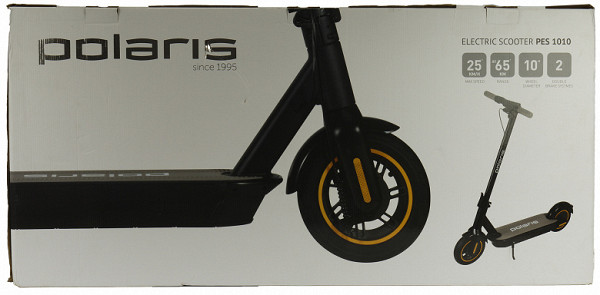
On the side edges we will find brief technical information, basic safety rules and additional photographs of the model.
Having opened the box, inside we found:
- the scooter itself
- Charger
- assembly kit: M5 hex key, wheel valve extension, set of M5 and M6 screws, M6 hex key, kickstand
- instruction manual, warranty card
At first sight
So, let's get to know the scooter and take a closer look at it. But first it has to be assembled.

This is not difficult to do. It is enough to tighten eight screws.

So, using M6 screws and a hex wrench, we secure the footrest...
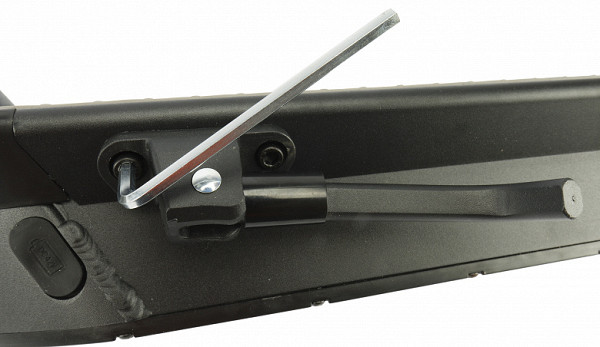
To unfold the scooter, lift the bracket on the steering wheel, release it from the lock and open the steering column, securing it with a lever. After this, secure the lever with a rotating ring. Then we install the handlebar on the base of the scooter, connect the wires and secure the M5 screws using a hex key.
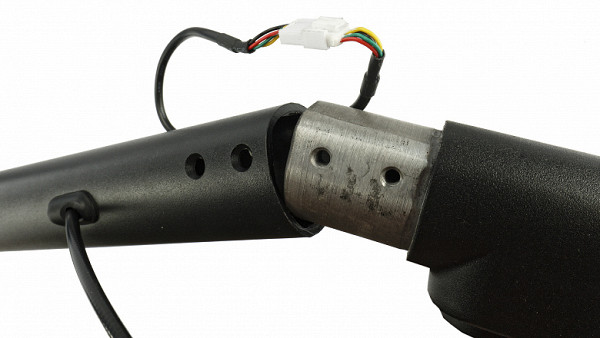
Before using, make sure the battery is fully charged. The scooter is ready for use! However, before that, let's take a closer look at it.
The metal stand of our scooter is painted matte black. Inside the pillar there are wires that connect to the throttle handle and the instrument panel, and the brake cable also partially runs through. To protect against moisture, rubber plugs were used, which we adjusted a little, since some of them were not installed quite straight.

The height of the stand is not adjustable. Thus, the distance from the surface of the earth to the steering wheel is 115 cm, and to the supporting platform — a little less than a meter.
At the bottom of the stand there is a folding mechanism that allows you to fold the scooter.

To install the stand in the unfolded state, we use the folding locking lever. A locking ring is provided to prevent accidental opening. The sequence of actions to prepare the scooter for use is as follows: unfold the stand, lift the lever, turn the ring so that the latch fits into the groove on the lever handle.
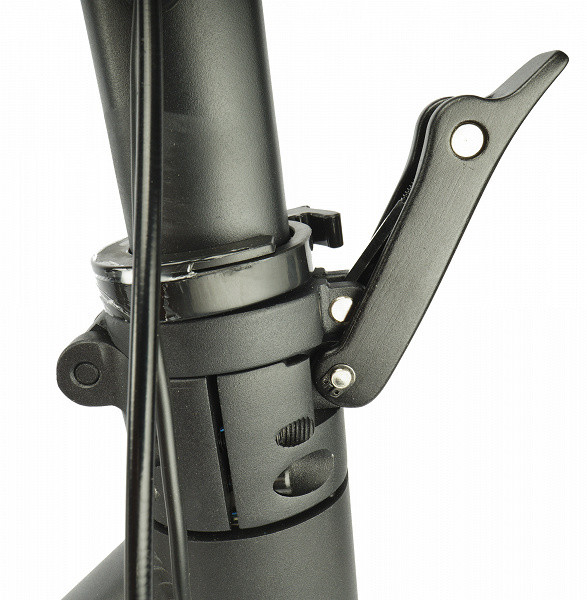
We originally intended for the flip lever to latch on its own, with the locking ring just for added security. However, no matter how we adjusted the position of the lever (which contains a simple single screw design), we were only able to install it so that the ring was firmly locked in place.
Thus, the plastic ring is the only mechanism for securely fixing the stand. Opinions may differ regarding its reliability. We can only note that such a plastic ring is a standard solution for many folding models.
When folded, the steering column can be fixed to the rear fender. The handlebar has a spring-loaded latch that engages the hook. The folded scooter can be lifted and carried by the steering column. However, we would recommend doing this carefully as the plastic fender does not appear to be very strong and regular pressure on it may cause it to break. The reliability of the entire structure can be enhanced by installing an additional wing mount, which is easy to do and will significantly increase overall reliability.
The width of the handlebar is 48 cm. The handles are equipped with ergonomic gray grips made of corrugated rubber, which improve the grip of the palm on the handle.

Next to the left grip there is a bell (to use it, you need to turn the ring), to the right is the mechanical brake handle.
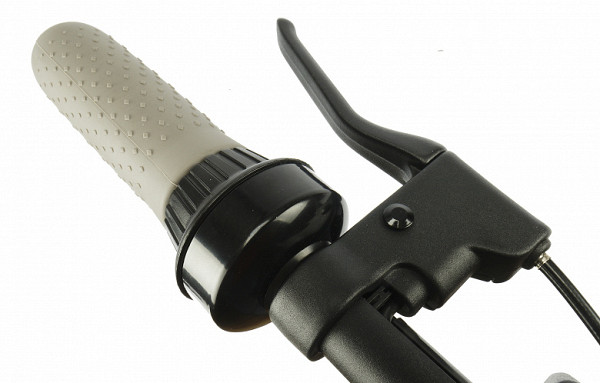
In the center we see the power button, and above it, in the center, is the dashboard.
To the right of the dashboard is the strut lock in the folded position, and to the right is the throttle handle.
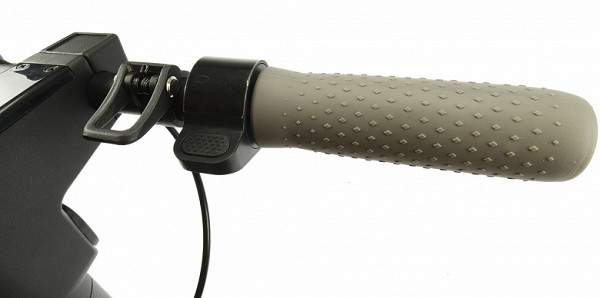
There is a headlight on the front of the steering column to illuminate the road while driving in the dark.
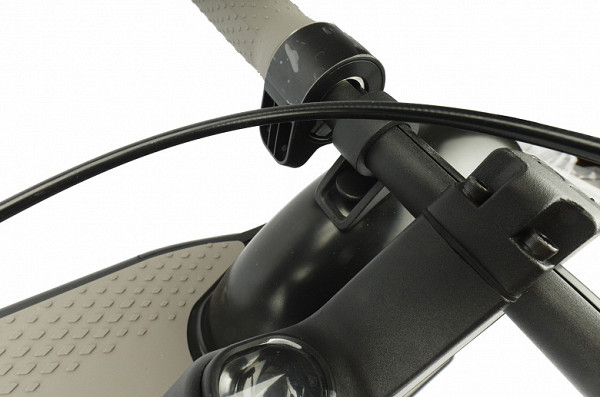

On the rear fender there is a red parking light that operates in automatic mode.
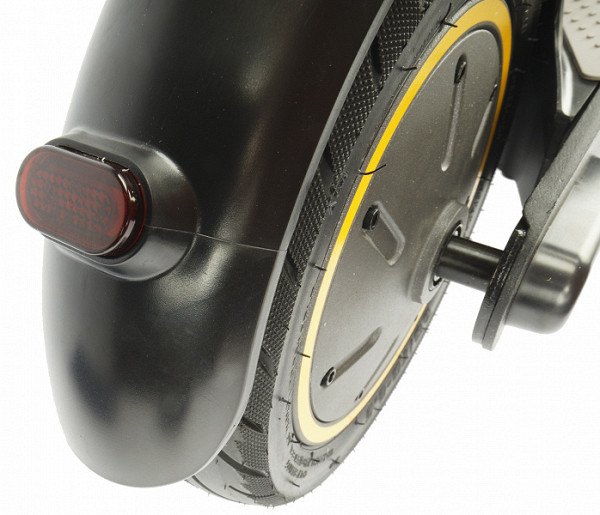
The deck, or support platform, measures 17 cm wide and 50 cm long (measured from wheel to wheel). The upper is covered in rubber material with grooved areas for a stable foot fit. The Polaris logo is located in the center of the deck.

The deck platform measures 17 cm wide and 50 cm long (measured from wheel to wheel). The rubber surface with grooved zones provides excellent grip, allowing even people with large feet to stand confidently when placing their feet at an angle. The shoes do not slip, which adds comfort and safety to using the scooter.
The height of the deck above the ground is 8.5 cm, and to the battery box — 7 cm. This is important to consider in order to avoid hitting the battery box when crossing curbs and stones.
Inflatable wheels have a diameter of 10 inches. The scooter does not have shock absorbers, so vibrations and shocks will have to be compensated mainly by your own stability and attentiveness on uneven roads.
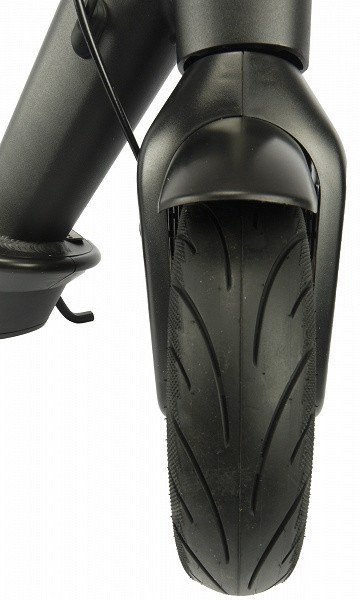
The wheel tread does not have a deep anti-skid pattern. Wheel grip is expected to be good, but not ideal. This type of scooter is more suitable for urban environments than off-road use.
The front wheel has a handbrake cable that can be fine-tuned for optimal performance. The brake mechanism is hidden under a protective cap and is not visible from the outside.
The Polaris PES 1010 electric scooter is a rear-wheel drive model. It has a 350W electric motor located in the rear wheel, as well as an electric brake.
The folding footrest is not very long, but it reliably holds the scooter in an upright position.

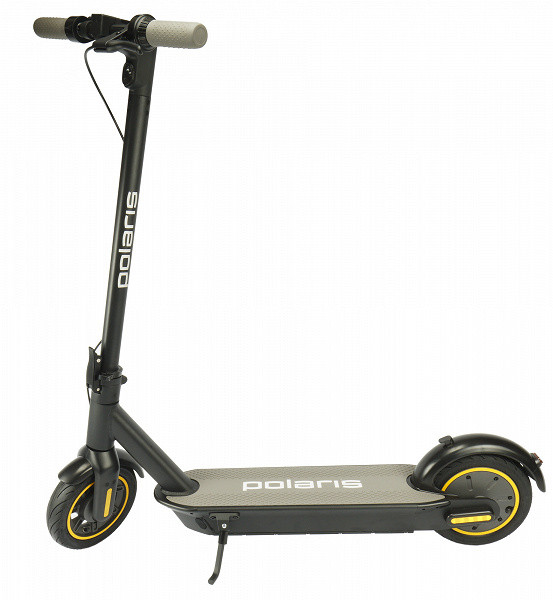
Apart from the headlight and tail light, the Polaris PES 1010 scooter does not have additional lighting. To improve visibility on the road, reflective linings (reflectors) are used, two pieces on each side.
The scooter is charged through a special connector located in the front left. The connector is protected by a rubber plug that prevents water from entering.
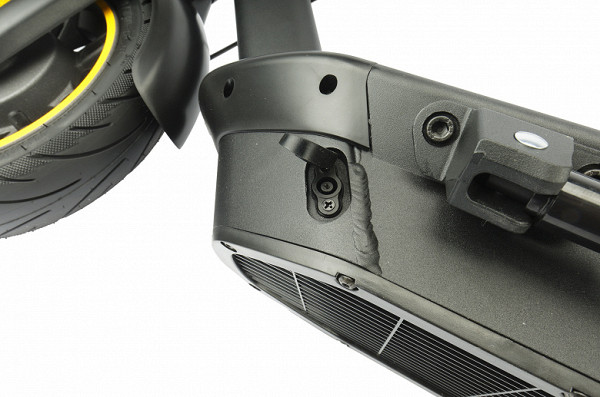
Opening the bottom plastic cover, we are finally convinced that the Polaris PES 1010 is a clone of the Ninebot by Segway G30. Our assumptions were confirmed, but we decided not to make such statements until we checked it personally.
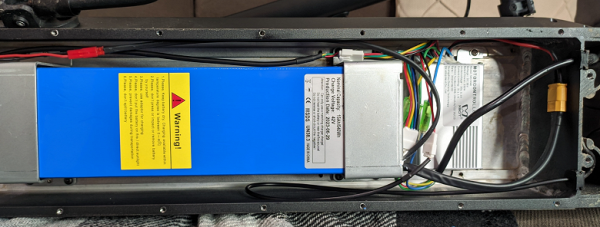
We immediately noticed a different battery from that used in Ninebot (and about one and a half times more affordable on Aliexpress). We did not find any other significant differences.
However, the question remains which version of the hub motor is used in our Polaris: the sixth, which provides better acceleration and is suitable for uphill riding, or the ninth, which has more power. Markings on the wheel itself were not found, and we have not yet been able to visually distinguish them (we ask experienced users to share their knowledge in the comments).
The charger is a heavy adapter block to which a cable and plug are connected. The second cable connected to the scooter is fixed. The total length of the two cables is a comfortable 2.1 m. It is worth noting that the charging connector here is not entirely standard. We don't know how common this is in the e-scooter world (we'd appreciate reader comments), but if the cable is damaged, it will likely take some time to find a replacement. The output parameters of the charger are 42 V, 2 A (84 W).
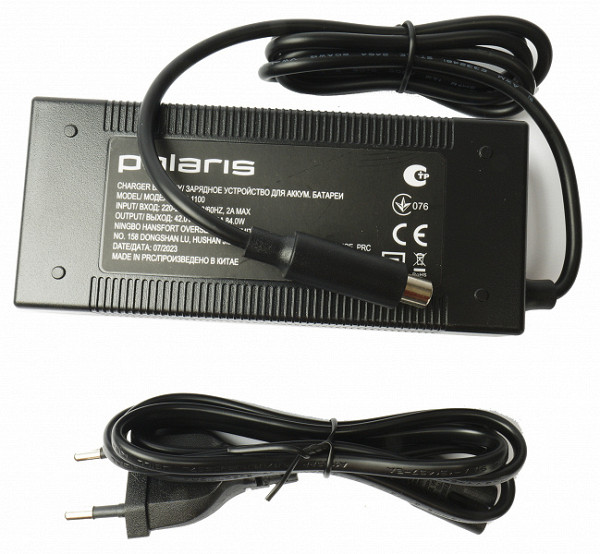
The kit included a valve extension, which allows you to inflate the wheel with increased comfort (you don’t have to crawl under the scooter with a pump).
Instructions
The instruction manual is presented in the form of a colorful brochure on 47 pages, printed in Russian, Ukrainian and Kazakh languages. The document contains a detailed description of the scooter device with an explanation of the functions of all components, recommendations for use, safety rules, as well as recommendations for the care and maintenance of the device.

The necessary actions and operations are provided with simple and understandable illustrations, making it easy and simple to understand all the nuances.
Control
The dashboard of the scooter is an LED display that displays all the necessary information.
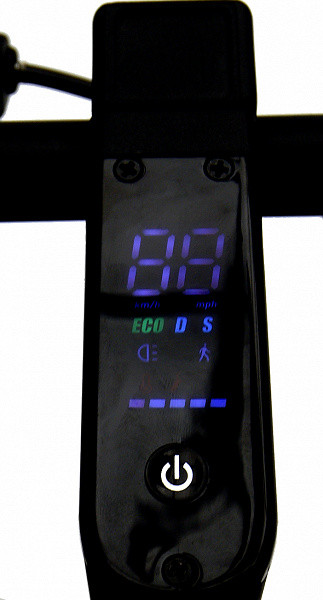
The scooter turns on and off with a long press on a single button, which also has an LED backlight.
After turning it on, a short press on the button controls the headlight — turns it on or off, and a double press cyclically switches operating modes.
The display shows the following information (from top to bottom):
- current speed
- selected mode
- headlight operation status (on or off)
- “pedestrian” mode (speed limit up to 6 km/h)
- battery charge level (scale of rectangular dies)
The scooter has 4 driving modes:
- Eco — to save energy, maximum speed up to 12 km/h, recommended for beginners
- D — standard mode, maximum speed up to 18 km/h
- S — sport mode, maximum speed up to 25 km/h, recommended for experienced users
- Pedestrian mode limits speed to 6 km/h, suitable for walking on sidewalks with many pedestrians.
Switching modes is accompanied by sound signals. The display brightness is sufficient for confident reading of information even in bright sunlight.
Also on the control panel there are symbols for a wrench and a regular key for a lock, presumably used in service mode, but the exact purpose of these symbols is not indicated in the instructions.
Exploitation
Before you start using the scooter, it is recommended to make sure that all parts are correctly assembled, the screws are tightened, and there are no backlashes or looseness.
To start moving, you need to stand on one foot on the support platform, push off the ground with the other foot, and then press the gas lever. The scooter does not start from a standstill until it receives a minimum acceleration, which eliminates accidental activation.
The front light illuminates the road surface without dazzling others.
The gas lever is spring-loaded and returns to its original position. The speed is adjusted depending on the selected mode: in the “pedestrian” mode, pressing has almost no effect on the speed, and the middle position of the lever corresponds to approximately 3 km/h. In sport mode, even a slight press significantly increases the speed to 12-13 km/h.
Releasing the gas lever activates automatic smooth braking. For active braking, the handbrake handle is used; the braking distance is about 5 meters, while the scooter remains stable due to the braking of both wheels.
The device is equipped with a cruise control function, activated when the gas lever is held in one position for more than 7 seconds. When triggered, a short signal sounds and the scooter continues moving at the fixed speed. To reset the function, just briefly press the gas lever or use the front brake.
A special feature of cruise control is that it records the position of the throttle lever, and not the current speed. This means that if the speed decreases after activation, the scooter will accelerate to the set speed as soon as possible.
Given the above, you need to pay attention to the correct speed setting in cruise control mode and be prepared to turn it off at the right time, especially when approaching intersections or traffic lights.
Care
Caring for the scooter is simple: use a soft, damp cloth to clean. Do not use alcohol, gasoline, kerosene or other volatile or corrosive solvents. Avoid high pressure water.
Before cleaning, make sure the scooter is turned off and check that the rubber cap of the charging port is closed.
Store the scooter in a dry and cool place. Try not to leave it outside for long.
Our measurements
During testing, we studied the ease of use of the scooter on various surfaces, rode long distances and assessed its ability to overcome hills. An important aspect was the user’s weight, which significantly affects the power reserve and overall travel comfort.
The main tests were carried out in the urban environment of St. Petersburg, where there are numerous stops and different types of surfaces.
A man weighing 80 kilograms acted as a test subject. The first test involved driving at various speeds: up to 12 km/h for 2.5 km, up to 18 km/h for 15 km and up to 25 km/h for 3.5 km. In total, we drove 21 kilometers in 2 hours 45 minutes, after which the battery charge dropped to a minimum level.
The second test involved driving at maximum speed within the city, including crossing bridges, park areas and underground passages. We drove 10 km in 1 hour and 10 minutes, then another 12.2 km in the same time. In total, we covered 22.2 kilometers on the original charge.
The overall comfort of travel was also affected by the condition of the battery. After reaching a critical charge level, the speed gradually decreased and the scooter eventually required charging.
Overall, we found the scooter to be suitable for urban use, cope well with obstacles and provide a comfortable ride.
conclusions
The Polaris PES 1010 electric scooter left us with a positive impression. It is ideal for city trips due to its simplicity and convenience. Large, wide wheels allow it to handle small road imperfections without the need for a shock absorption system.
The scooter accelerates easily and brakes gently, which ensures comfortable control. Confidence in control comes quickly — after just an hour of use.
The maximum speed of 25 km/h is quickly achieved and easily maintained. It is possible that if the firmware is changed, the scooter is able to reach higher speeds, but this requires additional checks, since at the moment the model is new, and information about available alternative firmware is limited.
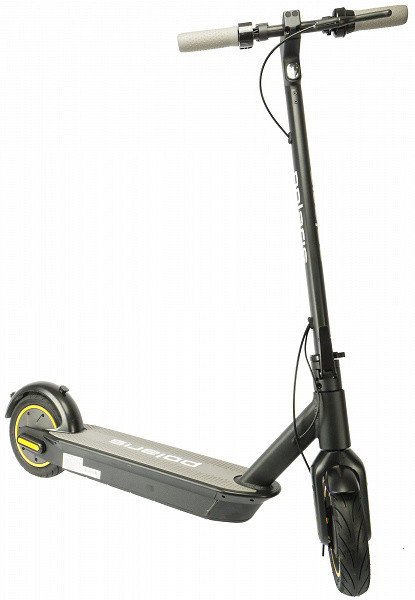
As for the declared range of 65 km, in practice we could not even come close to this value. In urban conditions, we drove up to 24 kilometers with a user weight of 80 kg. Based on this experience, we would not plan trips longer than 20 kilometers to avoid the risk of ending up with a discharged scooter at the most inopportune moment.
Polaris representatives claim that they can simulate conditions under which the scooter will be able to travel the entire stated 65 kilometers. We will monitor this information and update the review if we gain access to such data.
If the user's weight is lower, the roads are smooth, there are no traffic lights, and the scooter is used only in Eco mode, then we would focus on a maximum of 30 kilometers on a single charge.
Pros:
- stylish design
- build quality
- wheels with a diameter of 10″
- confidently picks up speed and does not lose it when overcoming obstacles
- speed up to 25 km/h
Minuses:
- small ground clearance
- lack of shock absorbers
- speed limit 25 km/h
- actual power reserve is less than stated
- lack of support for smartphone applications
- relatively high price


